This story originally appeared on Underscore Native News.
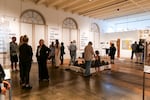
Community members mingle and admire art filling the gallery space at the Center for Native Arts and Cultures during the “Citizen Fellow: Art as Archive and Memory” exhibition opening on Sept. 19, 2024.
Nika Bartoo-Smith / Underscore Native News/ICT
Staff greeted visitors to the Center for Native Arts and Cultures on the evening of Sept. 19, handing out posters, magazines and bandanas emblazoned with the words “Citizen Fellow: Art as Archive and Memory.”
Mixed media art covered the gallery at the Center, a collection of work from 10 artists from the past 15 years of Native Arts and Cultures Foundation (NACF) fellowship programs. A twisted metal sculpture hung from the ceiling, paintings of Alaska Native women adorned one corner and a wood carving stood near the center of the room.
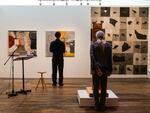
Two people spend time with different art pieces during the “Citizen Fellow: Art as Archive and Memory” exhibition opening at the Center for Native Arts and Cultures on Sept. 19, 2024.
Nika Bartoo-Smith / Underscore Native News/ICT
“Throughout my career, I’ve watched NACF use their capacity to empower others in the Native arts and creative community,” Andrea Hanley, citizen of the Navajo Nation, vice president of programs at NACF and the exhibit curator, said to a crowd gathered for the opening reception of “Citizen Fellow.” “This exhibition features artists who have centralized cultural consciousness and the influence of NACF in their work.”
Spanning mediums such as painting, sculpture, printmaking, video and installation, the exhibition runs through Nov. 23 at the Center for Native Arts and Cultures.
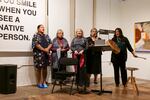
Members of the Portland All Nations Canoe Family share a song with a crowd gathered at the Center for Native Arts and Cultures for the “Citizen Fellow: Art as Archive and Memory” exhibition opening on Sept. 19, 2024.
Nika Bartoo-Smith / Underscore Native News/ICT
The Creation of ‘Citizen Fellow: Art as Archive and Memory’
In November 2023, the founding past president and CEO of NACF, T. Lulani Arquette, Kanaka ‘Ōiwi, invited Hanley onboard as vice president of programs. Hanley’s primary directive was to curate an exhibit showcasing 15 years of fellows. She pulled it off in under a year.
“In terms of the time frame, for me, it just meant that I needed to just start, just hit the ground running in terms of organizing the exhibition,” Hanley said. “Lots of people don’t realize how long it actually takes to put together a show.”
Hanley has over three decades of experience working with Native art institutions and curating exhibitions. She has worked with prestigious organizations including the National Museum of the American Indian and the Smithsonian Institution in Washington D.C. Most recently, she served as the chief curator at the Wheelwright Museum of the American Indian in Santa Fe, New Mexico.
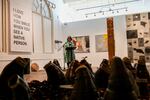
Andrea Hanley, citizen of the Navajo Nation, vice president of programs at NACF, spoke to an audience at the Center for Native Arts and Cultures on Sept. 19, 2024. She spent the last 10 months curating the exhibition “Citizen Fellow: Art as Archive and Memory.”
Nika Bartoo-Smith / Underscore Native News/ICT
That experience helped her to pull off an exhibition — spanning over a decade of work and sifting through dozens of fellows — in under a year.
“Museums don’t have anything on us,” Hanley said to those gathered for the opening reception. “In working in museums for the past 30 years, they don’t have anything on us. It was an absolute pleasure to be able to do this.”
Working on this exhibition, Hanley sought to curate an exhibit that showcased artists working with a variety of mediums and from a multitude of backgrounds and perspectives. The central theme of the whole exhibition is about looking to art as a way of archiving and remembering.
“Citizen Fellow also looks at preserving moments in time,” Hanley told the crowd gathered on Sept. 19. “Artists and the cultural leaders selected for the fellowships, both past and present, demonstrate commitments to their narratives and an inherent connectedness to creative acts of resistance, resilience and community engagement. And they reflect a powerful diversity of experiences.”
Meet the artist: Anna Tsouhlarakis
Mingling among the crowd, several of the 10 artists in the group exhibition visited with community members at the opening on Sept. 19, answering questions about their work and admiring other fellows’ artwork as well.
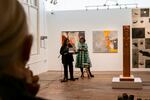
Shyla Spicer, citizen of Yakama Nation, president and CEO of NACF, welcomes community members to the Center for Native Arts and Cultures for the opening exhibition of “Citizen Fellow: Art as Archive and Memory” on Sept. 19, 2024 with Andrea Hanley, citizen of the Navajo Nation, exhibit curator and vice president of programs at NACF.
Nika Bartoo-Smith / Underscore Native News/ICT
“Tonight, we celebrate our artists and the impactful work that they contribute to the cultural landscape,” said president and CEO of NACF Shyla Spicer, citizen of Yakama Nation, as she looked out at the crowd gathered to celebrate the exhibition opening. “We thank you for your dedication to your practices and the bravery you show in showing your work to the world. You’re unflinching in your resolve to make the world more beautiful, equitable and sustainable.”
Speakers stood at the front of the gallery space surrounded by art. On a wall of windows with the shades drawn three large canvas prints hung with spotlights illuminating their words.
“I really like the way you respect Native American rights,” one sign read, in all capital letters in Helvetica font. Another said “I love how you smile when you see a Native person.”
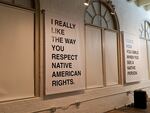
Canvas printed signs in all capitals with messages about respecting Native American people adorn one wall of the exhibition during the “Citizen Fellow: Art as Archive and Memory” exhibition opening at the Center for Native Arts and Cultures on Sept. 19, 2024. The pieces by Anna Tsouhlarakis, citizen of the Navajo Nation with Creek and Greek descent, are part of her series, the Native Guide Project.
Nika Bartoo-Smith / Underscore Native News/ICT
These messages are part of a recent series done by Anna Tsouhlarakis, citizen of the Navajo Nation with Creek and Greek descent, a 2015 National Artist Fellow at NACF. A transdisciplinary artist who does primarily performance, video, photography and installation work, Tsouhlarakis went to undergrad at Dartmouth College and received her master’s in fine arts in sculpture from Yale University.
The hanging tapestries Tsouhlarakis put up for the installation — three pieces inside and one on the back wall outside the building — are from a series called the Native Guide Project. Tsouhlarakis wanted to create a project that centered positive reinforcement when it came to conversations around race.
“— Anna TsouhlarakisI loved the idea of just putting these words out into the world, and making people be confronted by it, and having to deal with these words, with this text that’s in front of them.”
“Maybe you disregard it. Maybe it pisses you off, but you have to deal with it because you’ve thought about it for a minute. Or maybe you think, ‘Hey, I do that. Well done me.’”
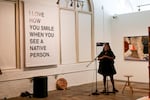
Anna Tsouhlarakis, citizen of the Navajo Nation with Creek and Greek descent, was a 2015 national artist fellow at Native Arts and Cultures Foundation. During the Citizen Fellow exhibition on Sept. 19, 2024, she talked about her Native Guide Project. The series of signs displays positive messages, such as “I appreciate how you recognize the diversity of Native Americans,” that she hopes make people stop and think.
Nika Bartoo-Smith / Underscore Native News/ICT
The project started with a large billboard in downtown Colorado Springs, Colorado. It has since evolved. During the entire month of November 2019, she sent them out as advertisements on Instagram, playing with the demographics of who received the messages.
All the messages are framed in a way that centers positivity and assumes the reader is doing a good job of respecting Native American people and the diversity within over 574 Native nations. “You did so many things well today, including respecting tribal sovereignty!” one of the Instagram posts reads.
“— Anna TsouhlarakisFor me, when people look at these and they say, ‘Well, how is that Native art?’ It’s exactly what I’m talking about — that evolution, that change with materiality.”
“The continued use of Native foundational knowledge and ways of being, of who we are. And so to me, these are traditional Native art. That’s the tradition I’m working in.”
Meet the artist: Abigail Romanchak
A charcoal-black-and-white series of woodcuts fused together hung on a wall behind the speakers during the Citizen Fellow opening exhibition. What looked like little islands covered the wooden blocks — they appeared to stick out in 3D.
Called “Pilina,” the woodcut by Abigail Romanchak, Native Hawaiian, was inspired by the Lahaina fires in Maui that devastated the community in August 2023. The fires made her think about water rights, and what the islands looked like before colonization.
“These shapes you’re seeing on the wall in Pilina are woodcuts, and they represent traditional moku,” Romanchak said to the crowd while gesturing to her work. “Traditional moku are land divisions that pre-contact Hawaiians lived by. And the land divisions would go from a mountain ridge down to the ocean, and Hawaiians were really thinking about the best use of land and sharing and community, whether it be through farming or fishing.”
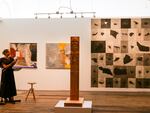
Abigail Romanchak, Native Hawaiian, pointed to her woodcut piece, “Pilina,” as she described its meaning to an audience gathered for the opening night of the exhibition Citizen Fellow: Art as Archive and Memory at the Center for Native Arts and Cultures on Sept. 19, 2024.
Nika Bartoo-Smith / Underscore Native News/ICT
Romanchak studied art at the University of Hawaii, Manoa. She was part of the 2015 Native Hawaiian Fellowship at NACF.
Much of her work looks at identity, land and water exploring topics such as climate change and human interaction with the environment.
“Pilina not only memorializes traditional land divisions, but I think I really want this piece to make people think about how our water is being shared and who owns our water today,” Romanchak said to the crowd.
Meet the artist: John Feodorov
A quiet observer during the Citizen Fellow opening exhibition, John Feodorov meandered through the crowd, pausing to spend time with each piece of art on display.
Feodorov, Diné, is an artist himself — in fact three of his mixed media pieces are on display as part of the Citizen Fellow exhibition.

John Feodorov, Diné, stands near two of his mixed media paintings during the “Citizen Fellow: Art as Archive and Memory” exhibition opening on Sept. 19, 2024 at the Center for Native Arts and Cultures. NACF elected Feodorov as one of the artists for its national artist fellowship in 2011.
Nika Bartoo-Smith / Underscore Native News/ICT
Growing up in the suburbs of Los Angeles, and studying art at California State, Long Beach, Feodorov and his parents traveled to New Mexico once a year to visit his grandparents. Both his visits and growing up as an urban Native person continue to influence the work he creates.
Two of Feodorov’s pieces hung on the wall behind the speakers during the opening exhibition on Sept. 19. He calls them “improvisational landscapes.” The pieces are mixed media: a combination of acrylic or oil paint with collage elements.
Feodorov created the three paintings on display at Citizen Fellow using Google map satellite images from the 1920s of his grandparent’s and mother’s New Mexico land allotment. One of the pieces featured an old photograph of his grandparents’ sheep barn and a plastic toy sheep.
“— John FeodorovI was finally becoming comfortable with thinking of what I did as Native American art.”
“It was always presented as that, but I never felt comfortable talking about it like that. Because I didn’t know that my work, at the time, really would have any connection with a Native person. But I knew that it was the work that I needed to do. I just didn’t know, you know? I thought that I was kind of an outlier.”

An elder holds the hand of a young child as they talk about a painting at the Sept. 19th opening for “Citizen Fellow: Art as Archive and Memory,” an exhibition at the Center for Native Arts and Cultures that runs through November.
Nika Bartoo-Smith / Underscore Native News/ICT
Regardless, he continued to create the work that called to him. Today, Feodorov’s work has been exhibited in places such as the National Museum of the American Indian, the Smithsonian Institution in Washington D.C., and the Institute of American Indian Arts Museum of Contemporary Native Arts in Santa Fe, New Mexico.
He is also an Associate Professor of Art at Fairhaven College at Western Washington University, hoping to inspire the next generation of artists.
The evolution of Native art
Feodorov has inspired other artists to expand what is defined as Native art as well.
“When I started seeing the works of James Luna or John Feodorov — all of these different artists that were kind of pushing the boundaries in different ways, I realized that I could possibly extend that trajectory as well within Native art,” Tsouhlarakis said. “I began to really reflect back and think about Native ways of making. That really made me realize up until the 1940s or ‘50s, Natives were always evolving the way that they made art.”

Cutouts and photos from James Luna’s installation titled “Take a Picture with a Real Indian” adorned a wall in the Center for Native Arts and Cultures during the “Citizen Fellow: Art as Archive and Memory” exhibition opening on September 19, 2024. Luna, of Luiseño, Puyukitchum, Ipai, and Mexican heritage, was a national artist fellow with the Native Arts and Cultures Foundation (2015). He passed on in 2018.
Nika Bartoo-Smith / Underscore Native News/ICT
Tsouhlarakis pointed to the silversmithing in Navajo Nation — something that came from materials brought over by the Spaniards.
The artists throughout “Citizen Fellow: Art as Archive and Memory” are pushing the limits of art and creating change through their perspectives — creating new definitions of what is within the boundaries of Native art.
“Our best resource is that we can adapt and we evolve and we grow as a people, and that’s why we’re still here, despite everyone wanting to get rid of us at different points,” Tsouhlarakis said. “That is something I’ve always held onto is how we are continually evolving and growing as Native people, as Native artists. And so it’s always been my goal to keep pushing those boundaries of, what does that mean to be Native-made? What does that mean to be Native art?”
Underscore Native News is a nonprofit investigative newsroom committed to Indigenous-centered reporting in the Pacific Northwest. We are supported by foundations and donor contributions. Follow Underscore on Facebook, X, Instagram and TikTok.